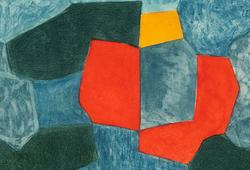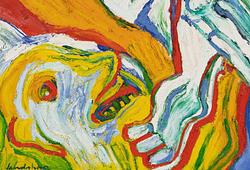Carl Milles
"The Hand of God"
Signed with rubber stamp C Milles and numbered 12/12. The motif originally conceived 1952 - 54. Foundry mark LJ cire perdue (Broncestøberiet Leif Jensen A/S, Kopenhagen, Denmark). Bronze, green/red patina, height 69.5 cm. Accompanied by an original pedestal from Millesgården, height 152 cm.
Alkuperä - Provenienssi
Acquired directly from Millesgården.
Kirjallisuus
Henrik Cornell, "Carl Milles", SAK 1963, , compare p. 182-187.
Henrik Cornell, "Carl Milles - hans liv och hans vänner", 1968, compare p .33.
Erik Näslund, "Carl Milles. En biografi", 1991, compare p. 209-212.
Muut tiedot
The Hand of God is one of Carl Milles' most personal and symbolically charged works. Created in the final years of his life, the sculpture expresses a deep existential longing for security, spirituality, and meaning. The powerful image of a human figure placed in a monumental hand portrays humanity's vulnerability in the face of the unknown - but also its trust in a higher, protective force. Here, man is not portrayed as newly created but as already complete - searching, questioning, and resting in something greater than himself.
Work on The Hand of God began around 1949, and Milles used his own left hand as a model. This personal imprint reinforces the interpretation of the sculpture as a representation of the artist's role as a mediator between humanity and the divine, between thought and form. For Milles, the hand symbolized not only God but also creative artistry. The hand motif recurs in several of his sketches from the same period, including God’s Gifts and New Worlds, where it serves as a metaphor for the mysteries of life and the human spiritual journey.
At the time, Milles was deeply influenced by spiritualist ideas and his own conception of the ‘unknown God’ - a creative force without a clear religious form, yet ever present in all things. Despite the universal appeal of the work, The Hand of God contains a spiritual core that approaches Christianity, though it avoids traditional religious symbols. In a 1950 letter, Milles wrote: “Almost daily I speak to God the Father,” offering insight into the personal relationship he felt with the divine.
The theme of the sculpture recalls Auguste Rodin’s work of the same name. However, while Rodin depicts the act of creation - the hand of God molding man from clay - Milles offers a different interpretation. As a young artist, Milles was strongly influenced by his time in Paris between 1904 and 1905, when he worked closely with Rodin as an assistant in his Meudon studio. This experience shaped Milles’ approach to art and his development as a sculptor, particularly in his exploration of movement and emotional expression. In Rodin’s work, the hand symbolizes the creation of man, but in Milles’ interpretation, the hand represents the only fixed element in a changing world. The young man balancing in the hand of God radiates both anxiety and trust - in prayer, wonder, or inner struggle. The hand that holds him steady symbolizes both protection and stillness.
The Hand of God is not an expression of the act of creation but rather of spiritual security - where man, though already formed, remains vulnerable and in prayer. The sculpture captures a sense of resting in something greater than oneself, reflecting Milles’ own belief in the artist as a mediator between humanity and the unknown.































































